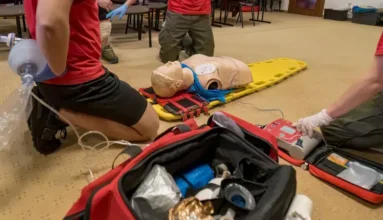ECG for maritime rescuers – HOMED
The Importance of Fundamental Understanding of Electrocardiograms (ECG) for Maritime Rescuers
In the unpredictable and often isolated environment of maritime rescue, having a crew member with the ability to assess and respond to medical emergencies is essential. One of the most critical skills for any maritime rescuer is the ability to understand and interpret an electrocardiogram (ECG). This knowledge enables rescuers to quickly evaluate the heart condition of an injured or ill individual, which is crucial in saving lives during cardiac emergencies.
What is an Electrocardiogram?
An ECG (electrocardiogram) is a test that measures the electrical activity of the heart. It shows how fast the heart is beating and whether its rhythm is regular or not. By placing small sticky sensors on the skin, usually on the chest, arms, and legs, the ECG machine records heart signals and creates a graph that shows how the heart is working. Doctors use this graph to detect problems like heart attacks, irregular heartbeats, or other heart conditions.
In simple terms, an ECG helps doctors “see” the heart’s activity to find any issues and keep it healthy.

Why Maritime Rescuers Need To Understand ECGs
ECGs are the gold standard for assessing heart activity, and in many cases, they are the first line of defense against life-threatening conditions. Understanding ECGs can significantly enhance a rescuer’s ability to take immediate action, monitor a patient’s heart over time, and work more effectively with remote medical teams via telemedicine.
Immediate Action During Cardiac Emergencies
When a crew member experiences a cardiac event—whether it’s a heart attack, arrhythmia, or other heart condition—every second matters. While telemedicine support allows for remote consultation with medical professionals, it takes time to send an ECG for interpretation and receive advice. In the critical minutes following a cardiac event, having a rescuer on board who can interpret the ECG readings can make the difference between life and death.
By recognizing dangerous signals on the ECG, such as arrhythmias, ischemia, or other abnormalities, rescuers can intervene immediately, performing critical care like administering medication, applying defibrillation, or positioning the patient for better circulation. This level of informed action can help stabilize the patient until advanced medical care is available.
Continuous Monitoring Beyond a Single ECG
In some maritime medical emergencies, transmitting a single ECG for review is not sufficient. There are situations where continuous monitoring is needed to track the patient’s condition over time. This means the maritime rescuer must not only know how to perform an ECG but also how to interpret multiple results and identify any changes in the patient’s heart activity.
For instance, subtle changes in the heart’s electrical activity over a few hours may signal that the patient is deteriorating or responding poorly to treatment. In such cases, continuous ECG monitoring can provide early warning signs of a worsening condition, allowing rescuers to react before it’s too late. Rescuers equipped with ECG interpretation skills can monitor real-time data and take action when necessary, ensuring that the patient’s heart is being carefully observed at all times.

Recognizing Pathological Signals
Interpreting an ECG involves recognizing a variety of pathological signals that can indicate the severity of a cardiac problem. Maritime rescuers must be able to identify key changes, such as:
- ST-segment elevation: A sign of myocardial infarction (heart attack).
- T-wave inversions: May indicate ischemia or cardiac stress.
- Irregular rhythms: Arrhythmias like ventricular fibrillation or atrial fibrillation.
- Bradycardia or tachycardia: Slow or fast heart rates that may signal underlying problems.
Being able to recognize these signals ensures that the rescuer can take the appropriate course of action. For example, in the case of ST-segment elevation, a rescuer would know to treat the situation as an emergency heart attack, which might involve administering medication or preparing for rapid evacuation.
Supplementing Telemedicine with Informed Decisions
While telemedicine plays a vital role in providing medical guidance to ships at sea, it cannot replace the need for immediate, hands-on monitoring in cardiac emergencies. A rescuer trained in ECG interpretation can serve as the eyes and ears of the remote medical team, providing real-time, detailed information that allows for more accurate treatment recommendations.
For instance, during a prolonged cardiac episode, the ability to describe in detail the changes observed on the ECG—such as fluctuations in the QRS complex or abnormalities in the heart rate—enables the telemedicine team to offer more precise instructions, reducing the risk of miscommunication. This leads to quicker, more effective interventions, especially when waiting for medical evacuation is not feasible.
Why ECG Knowledge Is Critical for Maritime Rescuers
As maritime rescuers, being able to interpret ECGs is more than an extra skill—it is a vital capability that can save lives. The ability to monitor and understand a patient’s heart activity allows rescuers to:
- Stabilize patients in the crucial moments following a cardiac event.
- Provide informed updates to telemedicine teams, leading to better remote decision-making.
- Prevent deterioration by recognizing early signs of serious heart conditions.
- Manage ongoing care through continuous monitoring in situations where evacuation may be delayed.
Understanding the Basics of ECG Function
At its core, an ECG measures the electrical activity of the heart through electrodes placed on the skin. The electrical impulses generated by the heart create a visual trace, which is recorded and analyzed to understand how the heart is functioning. The basic components of an ECG include:
- P Wave: Indicates atrial depolarization, signaling the start of the heart’s electrical cycle.
- QRS Complex: Represents ventricular depolarization, a crucial signal for understanding heart function.
- T Wave: Reflects ventricular repolarization, providing insight into recovery after contraction.
Maritime rescuers should be familiar with how these components behave in a healthy heart and what deviations from the norm might indicate. This knowledge allows them to take swift, informed actions, such as delivering CPR, administering medication, or applying a defibrillator if needed.
The Role of Training and Education
Although the availability of telemedicine systems on vessels has improved emergency care, nothing can substitute for having trained rescuers who understand the principles of ECG interpretation. Proper training in ECG use and analysis should be part of every maritime rescuer’s education. Not only does it empower rescuers to handle cardiac emergencies more confidently, but it also enhances the overall safety and well-being of the entire crew.
Conclusion: The Lifesaving Importance of ECG Knowledge
For maritime rescuers, understanding electrocardiograms is more than just an additional skill—it is a lifesaving capability that can make the difference
ECG for maritime rescuers


